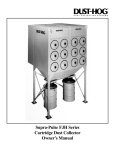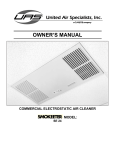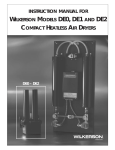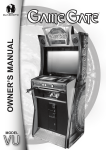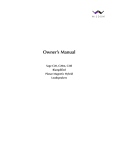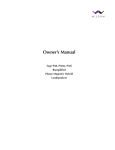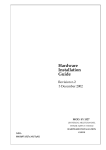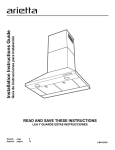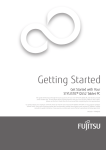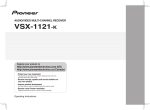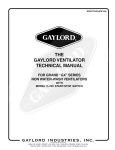Download Dust-Hog SUPRA-CONIC Troubleshooting guide
Transcript
Supra-Blast Cartridge Dust Collector Installation and Operation Manual TABLE OF CONTENTS Page 1. IMPORTANT NOTICE ........................................................................................ 1 1.1 General Cautions ........................................................................................ 1 2. INTRODUCTION ............................................................................................... 2.1 Unit Nomenclature ...................................................................................... 2.2 Description and Operation .......................................................................... 2.3 Air Filtering Operation ................................................................................. 2.4 Filter Cleaning Cycle ................................................................................... 1 1 2 2 2 3. SPECIFICATION TABLE .................................................................................... 4 4. INSTALLATION .................................................................................................. 4 4.1 Off Loading and Inspection ......................................................................... 4 4.2 Installation Planning .................................................................................... 4 4.3 Assembly of Standard Equipment ............................................................... 8 4.4 Electrical Installation ................................................................................. 12 4.5 Compressed Air Connection ..................................................................... 21 4.6 Assembly of Optional Equipment .............................................................. 21 5. OPERATION .................................................................................................... 5.1 Start-Up..................................................................................................... 5.2 Checklist .................................................................................................... 5.3 Checking the Pulse Cleaning System with Your Controller ....................... 5.4 Operating Adjustments.............................................................................. 27 27 27 28 28 6. SERVICE ......................................................................................................... 6.1 Cartridge Filter Removal and Replacement .............................................. 6.2 Cartridge Filter Seeding Procedures ........................................................ 6.3 Dust Removal ............................................................................................ 6.4 Servicing the Compressed Air Components ............................................. 6.5 Servicing the Direct Drive Blower and Motor System ............................... 6.6 Servicing Optional Return Air Safety Filters (HEPA/ASHRAE) ................. 6.7 Supra-Max Series Cartridge Filters .......................................................... 29 29 31 31 32 32 32 32 7. TROUBLESHOOTING GUIDE......................................................................... 33 8. ILLUSTRATED PARTS .................................................................................... 35 Supra-Blast Series Bill of Materials ................................................................. 36 i Supra-Blast Cartridge Dust Collector Revised 02/02 1. IMPORTANT NOTICE This manual contains important safety information and precautionary measures. It is impossible to list all potential hazards associated with every dust collection system in each application. Proper use of the equipment must be discussed with United Air Specialists, Inc. (UAS) or your local DUST-HOG® representative. Operating personnel must be aware of, and adhere to, the most stringent safety procedures. ! WA R N I N G A warning symbol means people may be injured if the procedures are not followed. ! C AU T I O N A caution symbol is used when equipment could be damaged if the procedures are not followed. 2. INTRODUCTION Thank you for selecting DUST-HOG dust collection equipment to assist you in your commitment to a clean and safe environment. We trust that in purchasing our product you have recognized our commitment to continually offer dust collection equipment engineered to each dust collection need and manufactured to the highest standards. If at any time you have a question about dust collection, please do not hesitate to call your local DUST-HOG representative or the nearest UAS customer service office listed on the back cover of this manual. The DUST-HOG Supra-Blast product line offers stateof-the-art cleaning power and dust collection capacity. Designed to collect process-generated dusts, Supra-Blast is the first centralized cartridge dust collector with UAS’ exclusive air distribution insert within the cartridge filter and QuickSeal filter access doors. The Supra-Blast dust collector shall not be used for any purpose not listed in this manual. 1.1 GENERAL CAUTIONS 1. Avoid mixing combustible materials such as aluminum, paper, wood or other organic dusts with dusts generated from grinding metals. A fire hazard could develop from sparks entering the dust collector. When collecting flammable or explosive materials, the dust collector should be located outdoors and incorporate the appropriate safety measures and/or accessories. 2. When collecting emissions from spark-producing processes, care must be taken to reduce any potential fire hazards. System design should include methods to prevent sparks from entering the dust collector. Dust collectors do not contain fire extinguishing equipment unless specifically ordered. Experts in the field of fire extinguishing equipment should be consulted for recommendations concerning proper fire detection and suppression systems. 3. Some dust collection systems require explosion venting. Consult your insurance underwriter, NFPA (National Fire Protection Association) Manual and your local fire authorities to determine the requirements for explosion venting. 4. Be careful and conscientious — consult national and local fire codes, waste disposal, safety and other appropriate authorities. Comply with their recommendations for the proper installation and operation of dust collection equipment. United Air Specialists, Inc. As you review this manual, refer to Figure 1 for assistance in identifying dust collector parts. The Supra-Blast Specification Table in Section 3 provides additional unit information. 2.1 UNIT NOMENCLATURE The Supra-Blast product line is separated into two models. SBS designates a single-filter configuration unit and SBD designates a double-filter configuration unit. EXAMPLE: SBS 4-2-H55 SBS – DUST-HOG Supra-Blast single-filter configuration unit 4– number of cartridge filters (2,4,6 or 8) 2– number of filter tiers H55 – unit base arrangement H55 - hopper with 44" (112 cm) clearance for standard 55 gallon (208 liter) drum SD - hopper with 26" (66 cm) clearance for UAS-supplied 30 gallon (114 liter) drum OB - open bottom construction BV - custom bin vent unit with open bottom 1 Revised 02/02 EXAMPLE: SBD 24-3-H55 SBD – DUST-HOG Supra-Blast double-filter configuration unit 24 – number of cartridge filters 3– number of filter tiers H55 – unit base arrangement H55 - hopper with 44" (112 cm) clearance for standard 55 gallon (208 liter) drum SD - hopper with 26" (66 cm) clearance for UAS-supplied 30 gallon (114 liter) drum OB - open bottom construction 2.2 DESCRIPTION AND OPERATION The DUST-HOG Supra-Blast is a high-efficiency, cartridge dust collector designed to eliminate airborne dust as it is generated. Contaminants are captured at the source(s), then conveyed through ductwork to the cartridge filter section (dirty air section) where the dust is collected. Clean air is then discharged from the unit through the clean air discharge. 2 Supra-Blast Cartridge Dust Collector 2.3 AIR FILTERING OPERATION The contaminated airstream is drawn into the dust collector where its velocity is reduced by inlet baffle plates to provide even air distribution across the entire surface area of the cartridge filters. This design enhances filtration efficiency by establishing a uniform “dust cake” on the filters. The airstream is then directed around the cartridge filters and down toward the hopper where the heavier particles discharge to the dust storage drum. The contaminated air then passes through the cartridge filters. The filter media strips the dust from the airstream allowing only clean air to pass through the cartridge filter. The air then passes into the clean air plenum, through a blower package and is discharged from the unit. 2.4 FILTER CLEANING CYCLE The dust collector is designed for on-line or downtime cartridge filter cleaning by means of a customersupplied compressed air system. During normal operation, the surface of the cartridge filters become loaded with contaminants. The reverse pulse cleaning mechanism provides brief bursts of compressed air, directed through the diaphragm valves, toward an air distribution tip and into the center of the cartridge filter. This pulsing action dislodges the collected particles from the media where they fall into the hopper and are discharged to the dust storage drum. The Supra-Blast is a high-efficiency, horizontallyoriented cartridge dust collector equipped with 15" (38 cm) outside diameter cartridge filters. The larger diameter Supra-Max Series cartridge filter design allows for lower pressure losses through the dust collector while increasing the amount of media contained in each filter. DUST-HOG Supra-Blast Series dust collectors have pre-engineered backward-inclined or radial-type optional blower packages in 3, 5, 71/2, 10, 15, 20, 25 and 30 HP (2.2, 3.7, 5.5, 7.5, 11, 15, 18.5 and 22 kW) assemblies. During the cleaning cycle, each row of cartridge filters is cleaned individually. The solid-state sequential timer actuates a solenoid valve, which allows an air diaphragm valve to open for approximately 100 milliseconds. High-pressure air from the air manifold reservoir is directed through the diaphragm valve toward the air distribution tip mounted on the tubesheet in front of the cartridge filter. The air is then directed into the cartridge filter. The filter’s air distribution insert maximizes the compressed air energy to increase the amount of collected dust released from the filter surface. There are two primary modes of operation — the air filtering operation and filter cleaning cycle. Both modes of operation are shown in Figure 1. The dislodged dust removed from the filter is swept downward into the hopper. The remaining filters are cleaned sequentially. The sequencing is factory preset at 10-second intervals and is adjustable to adapt to your particular cleaning needs. United Air Specialists, Inc. Supra-Blast Cartridge Dust Collector Figure 1. Supra-Blast Air Filter Operation & Cleaning 44-10001-0001 Revised 02/02 United Air Specialists, Inc. 3 Supra-Blast Cartridge Dust Collector Revised 02/02 3. SPECIFICATION TABLE Supra-Blast Model Filter Quantity Total Supra-Netmax Filter Media Area (FT2) (M2) 620 58 1,240 115 1,860 173 2,480 230 Unit Weight Valve Quantity Module Quantity 2 4 6 8 1 1 2 2 (LBS) 1,298 1,859 2,554 3,090 (KGS) 589 843 1,158 1,402 SBS SBS SBS SBS 2 4 6 8 - 2 2 2 2 - H55 H55 H55 H55 2 4 6 8 SBD SBD SBD SBD 8 16 24 32 - 2 2 2 2 - H55 H55 H55 H55 8 16 24 32 2,480 4,960 7,440 9,920 230 461 691 922 4 8 12 16 1 2 3 4 2,363 3,909 5,533 7,282 1,072 1,773 2,510 3,303 SBD SBD SBD SBD SBD SBD 12 24 36 48 60 72 - 3 3 3 3 3 3 - H55 H55 H55 H55 H55 H55 12 24 36 48 60 72 3,720 7,440 11,160 14,880 18,600 22,320 346 691 1,037 1,382 1,728 2,074 6 12 18 24 30 36 1 2 3 4 5 6 2,824 4,687 6,628 8,694 10,635 12,576 1,281 2,126 3,006 3,944 4,824 5,704 SBD SBD SBD SBD SBD SBD SBD SBD 16 32 48 64 80 96 112 128 - 4 4 4 4 4 4 4 4 - H55 H55 H55 H55 H55 H55 H55 H55 16 32 48 64 80 96 112 128 4,960 9,920 14,880 19,840 24,800 29,760 34,720 39,680 461 922 1,382 1,843 2,304 2,765 3,225 3,686 8 16 24 32 40 48 56 64 1 2 3 4 5 6 7 8 3,313 5,521 7,807 10,218 12,504 14,790 17,201 19,487 1,503 2,504 3,541 4,635 5,672 6,709 7,802 8,839 4. INSTALLATION 4.1 OFF LOADING AND INSPECTION Supra-Blast dust collector modules are shipped assembled on a skid(s). Other skids will contain the hopper/leg assembly and other components. Other accessories (afterfilter assemblies, blower packages, dust storage drums, silencers, etc.) may be on additional, separate skids. ! C AU T I O N Lift the dust collector components by the packing skids or use the external lifting lugs provided on the filter module. Do not lift the filter module of the dust collector by placing lift truck forks through the cartridge filter access doors. The filter support rails or the conical air distribution tips installed on the tubesheet could be damaged. 4 Upon receipt of your unit, check for any shipping damage. A damaged carton indicates that the equipment may have received rough handling during shipping that may have caused internal damage. Notify your delivery carrier and enter a claim if any damage is found. 4.2 INSTALLATION PLANNING The proper location of your dust collection equipment is very important. Refer to Figures 2 and 3 for typical installation details. Certain items should be considered when locating the unit, such as emptying of the dust storage drum(s), filter removal requirements, compressed air connections, access to the clean air plenum, electrical connections, blower location and discharge direction. The shortest duct length with a minimum number of elbows will maximize the performance of the unit. Ease of maintenance should also be considered when selecting the location and orientation of the system. Refer to Figure 4 for recommended unit clearances. United Air Specialists, Inc. Supra-Blast Cartridge Dust Collector Figure 2. Supra-Blast SBS Typical Installation Diagram 44-10044-0001, REV A Revised 02/02 United Air Specialists, Inc. 5 Supra-Blast Cartridge Dust Collector Figure 3. Supra-Blast SBD Typical Installation Diagram 44-10003-0001, REV A Revised 02/02 6 United Air Specialists, Inc. Supra-Blast Cartridge Dust Collector Figure 4. Recommended Unit Clearances 44-10007-0001 Revised 02/02 United Air Specialists, Inc. 7 Supra-Blast Cartridge Dust Collector Revised 02/02 In the case of spark producing processes, system design should incorporate measures to prevent live sparks from entering the dust collector. Consult local authorities for the location of this unit and any additional precautions to consider when collecting combustible, explosive or hazardous dusts. General warnings and cautions are provided in Section 1.1. The Supra-Blast dust collector should be mounted on a solid, level, reinforced concrete foundation. Other mounting options are also possible. Structural calculations for the foundation or other mounting arrangements must include the weight of the collected material and the weight of all auxiliary equipment installed with the dust collector (ductwork, abrasive inlet, blower package, afterfilter assembly, etc.). The Supra-Blast Specification Table in Section 3 provides unit weights. These weights must be considered together with wind loading, seismic loading and other live load ratings when designing the dust collector foundation support structure. Consult a professional engineer when designing the foundation for the unit. Interconnecting ductwork should be designed to include a volume control damper for regulating system design airflow. United Air Specialists, Inc. offers optional volume control dampers which can be installed on the air inlet/ outlet ductwork of the Supra-Blast unit to regulate airflow. Ductwork must be properly sized to meet the recommended air velocities for the material being collected. Follow ductwork design methods as listed in the Industrial Ventilation Manual as recommended by the American Conference of Governmental Industrial Hygienists. 4.3 ASSEMBLY OF STANDARD EQUIPMENT ! C AU T I O N Use adequate safety measures when lifting and assembling any heavy components. Consult your plant safety personnel for recommendations. Remove all crating, strapping and hold-down bolts. Locate all hardware bags, sealant and other assembly materials provided with your unit. HOPPER ASSEMBLIES The Supra-Blast series filter module is designed to mount directly on top of the hopper assembly. A hopper assembly consists of a hopper bin, legs, side diagonal sway braces, rear diagonal sway braces, front horizontal brace and hardware installation kit. Most Supra-Blast hopper bins will be factory assembled with the legs and sway bracing. Some hopper assemblies may be shipped in pieces and will need to be assembled at the site. If the hopper assembly is factory assembled, position hopper and legs on the mounting pad. Shim legs as required and secure leg assemblies to concrete mounting pad with appropriate anchoring hardware. Anchors should be provided by customer or contractor according to local codes. If the hopper sections are shipped in pieces for field assembly, position legs as shown in “Plan Detail” on the unit sales drawing. Bolt on sway braces using hardware as shown in Figures 5 and 6. Leave all hardware handtight; shim legs as required. Extend hopper leg alignment bolts through leg upper surface (refer to Figure 7, View G). Fit hopper over leg assemblies, positioning the corner holes of the hopper over the alignment bolts in each leg gusset corner (refer to Figure 7, View H). Secure leg assemblies to concrete mounting pad with appropriate anchoring hardware. Anchors should be provided by customer or contractor according to local codes. FULLY-ASSEMBLED FILTER MODULE SECTIONS Apply two ribbons of sealant to hopper flange to create “figure 8” pattern around mounting holes (refer to Figure 7, View H). ! C AU T I O N In preparing to attach the filter module to the hopper, connect lifting slings and spreader bars to all filter module lifting lugs with clevis pins. Use spreader bars to distribute the load evenly. Location must be clear of all obstructions, such as utility lines or roof overhangs. Place filter module onto hopper/leg assemblies, positioning filter module corner holes over alignment pins in leg gussets (refer to Figure 8, Detail K). Drift pins will also be useful for locating the filter module section onto the hopper. 8 United Air Specialists, Inc. Figure 5. Leg Assembly Details FIELD_INSTALL_DWG1/ SUPRABLAST/SALES/ FIELD_INSTALL_DRW/ SHEET 1 Revised 02/02 Supra-Blast Cartridge Dust Collector United Air Specialists, Inc. 9 Figure 6. Leg Brace Assembly Details FIELD_INSTALL_DWG1/ SUPRABLAST/SALES/ FIELD_INSTALL_DRW/ SHEET 2 Revised 02/02 10 Supra-Blast Cartridge Dust Collector United Air Specialists, Inc. Supra-Blast Cartridge Dust Collector Revised 02/02 NOTE: Each hopper assembly is equipped with four 1/2" (13 mm) pry locations — two holes on front flange and two holes on rear flange. Refer to Figure 8, Detail K, to aid in aligning the hopper flange with the module flange. With filter module still supported, use hardware (refer to Figure 8, Section P-P) to bolt the hopper and filter module together. Securely tighten all hardware at the filter module and hopper. Recheck leg assembly sway braces to ensure they are tight. Install fasteners (bolt, flat washer, lock-washer, nut) to all four pry locations. Disconnect lifting slings and spreader bars used for installation. MULTIPLE, BOLT-TOGETHER MODULE SECTIONS For units that have multiple, bolt-together module sections, remove the row of filters from the modules nearest the bolting flange (refer to Section 6.1). Protect the doors and filters removed by placing in a safe area away from work area. Identify the different module sections. There are left (bolt flange on the right side), right (bolt flange on the left side) and possibly center (bolt flanges on both sides) module sections. Install all hopper/leg assemblies as previously described. With multiple hoppers, the leg assemblies should be bolted together (refer to Figure 5, Section F-F). Apply two ribbons of sealant to only the first hopper flange to create “figure 8” pattern around mounting holes (refer to Figure 7, View H). ! C AU T I O N In preparing to attach the filter module to the hopper, connect lifting slings and spreader bars to all filter module lifting lugs with clevis pins. Distribute the load evenly. Location must be clear of all obstructions, such as utility lines or roof overhangs. Place the appropriate filter module onto the hopper/leg assembly to which the sealant has been applied, positioning filter module corner holes over alignment pins in leg gussets (refer to Figure 8, Detail K). Drift pins will also be useful for locating the module section onto the hopper. NOTE: Each hopper assembly is equipped with four 1/2" (13 mm) pry locations — two holes on front flange and two holes on rear flange. Refer to Figure 8, Detail K, to aid in aligning the hopper flange with the module flange. United Air Specialists, Inc. With the filter module still supported, use hardware (refer to Figure 8, Section P-P) to bolt the hopper and filter module together. Securely tighten all hardware at the filter module and hopper. Recheck leg assembly sway braces to ensure they are tight. Install fasteners (bolt, flat washer, lock-washer, nut) to all four pry locations. Disconnect lifting slings and spreader bars used for installation. Apply sealant to the next hopper to receive a filter module (refer to Figure 7, View H). Apply sealant to the side bolting flange of the next filter module to be installed using the “figure 8” pattern (refer to Figure 9, Detail J). Place this module on its hopper. Use the hardware provided (refer to Figure 9, Detail L) and bolt the module sections together. Bolt the filter module to the hopper (refer to Figure 8, Section P-P). Securely tighten all hardware at the filter module and hopper. Recheck leg assembly sway braces to ensure they are tight. Install fasteners (bolt, flat washer, lock-washer, nut) to all four pry locations. Disconnect the lifting slings and spreader bars used for installation. Repeat this process until all the module sections are in place, securely fastened and anchored to the foundation. Recheck all hardware connections to make certain they are securely tightened. Remove lift slings and spreader bars and clear all tools from the work area. NOTE: Make certain all bolts (including the anchor bolts) are properly tightened before proceeding with the remainder of the installation. Install all cartridge filters removed at the beginning of the installation process and install the filter access doors (refer to Section 6.1). CLEAN AIR SECTION BOTTOM ACCESS PANEL INSTALLATION The bottom access panel and its gasket are shipped loose with installation hardware. If the bottom access will not be used for discharge ductwork, attach the panel to the bottom opening using the hardware provided. For top-mount blower packages of 20 HP (15 kW) or larger, an additional set of support legs is provided. The additional support legs must be mounted under the filter module supporting the blower package (refer to Figure 10). Bolt the mounting plate to the bottom of the appropriate clean air plenum with the hardware provided. Bolt the leg assemblies to the mounting plate 11 Supra-Blast Cartridge Dust Collector Revised 02/02 with the hardware provided. Secure leg assemblies to the concrete mounting pad with appropriate anchoring hardware. 4.4 ELECTRICAL INSTALLATION ! C AU T I O N All electrical work should be performed by a qualified electrician in accordance with local electrical codes. Disconnect electrical power before installing or servicing any electrical component. ! C AU T I O N Avoid mounting the Supra-Clean, Supra-View or Supra-I.Q. Panel on the collector due to vibration generated from blower assembly and the pulsing system. 4.4.2 PULSE CLEANING CONTROLS For a more in-depth explanation of the cleaning control features and options, refer to Section 5 or the Installation and Operation Manual supplied with the Supra-Clean timerboard, Supra-View Panel or Supra-I.Q. Diagnostics Panel. GENERAL Several types of standard electrical components can be installed to control and monitor your dust collector ensuring proper cleaning of the cartridge filters. A fan motor starter circuit is required to start and stop the system. The motor starter circuit should consist of a properly-sized, fused disconnect or circuit breaker, contactor and overload relay for short circuit and overload protection of the blower package. A 115/1/60 low voltage (2 amp) control circuit is required for the pulse cleaning controls. Any one of the following control configurations can be used (refer to Figures 11-13 for wiring schematics): • Motor starter with Supra-Clean timerboard for continuous pulse (Magnehelic® Guage). Refer to Figure 11 for recommended wiring. • Motor starter with Supra-Clean timerboard for setpoint pulse (Photohelic® Guages). Refer to Figure 11 for recommended wiring. • Motor starter with Supra-View Panel for self-contained differential pressure display, pulse control and alarm. Refer to Figure 12 for recommended wiring. • Motor starter with Supra-I.Q. Diagnostics Panel for complete monitoring and automated pulse control. Refer to Figure 13 for recommended wiring. Refer to UAS sales order to verify the control configuration purchased with your unit. 4.4.1 MOUNTING OF THE CONTROLS Mount the motor starter for the fan motor control in a convenient location. The motor starter is provided by the customer, unless specifically ordered from UAS. Mounting hardware for a UAS starter panel is provided by the customer or contractor. Mount the solid-state cleaning controls (Supra-Clean, Supra-View or Supra-I.Q.) in a convenient location. It is recommended that the controls be mounted on a wall or pedestal in a convenient area subject to minimal vibration and electrical noise. 12 4.4.3 SOLENOID VALVE ENCLOSURE WIRING The solenoid valves at the dust collector must be wired correctly to the pulse controls. Refer to Figure 14 when making connections from the pulse controls (SupraClean timerboard, Supra-View Panel or Supra-I.Q. Diagnostics Panel) to the solenoid valve enclosure(s). Example: Figure 14 shows the SBD-XX-4 having eight valve locations per module. This means when the system pulses, “1” is the first pulse in the sequence, “2” is the second, “3” is the third, etc. When multiple dust collector modules are installed, daisy chain the wiring so that each solenoid valve with the same module location will pulse at the same time. This means all #1 solenoid valves are tied together and wired to pulse controller “OUT 1,” #2 solenoid valves are tied together and wired to pulse controller “OUT 2,” etc. Refer to Figure 14 for the Supra-Blast dust collector solenoid valve wiring information. When cleaning, the pulse valves sequence left to right, top to bottom. Unless specified on the UAS sales order, the customer will supply interconnecting material (conduit, wiring, etc.) from the pulse controls to the dust collector. 4.4.4 HEATER WIRING In cold or damp environments, the heater serves to prevent the electric solenoid valves from freezing due to cold temperatures or condensation. If optional solenoid valve heater is purchased, each solenoid valve enclosure will contain a 100-WATT cartridge heater internally prewired to a thermostat. The customer must supply a separate, 100-130VAC, 50-60Hz, 1 amp supply power to the heater circuit for each module. The supply must be available to the module solenoid valve enclosure(s) at all time (even when the blower is shut down) to ensure temperature regulation inside each solenoid valve enclosure is continual. When United Air Specialists, Inc. United Air Specialists, Inc. Figure 7. Hopper Assembly Details FIELD_INSTALL_DWG1/SUPRABLAST/SALES/FIELD_INSTALL_DRW/SHEET 3 Revised 02/02 Supra-Blast Cartridge Dust Collector 13 14 FIELD_INSTALL_DWG1/SUPRABLAST/SALES/FIELD_INSTALL_DRW/SHEET 4 Figure 8. Module to Hopper Assembly Details Revised 02/02 Supra-Blast Cartridge Dust Collector United Air Specialists, Inc. United Air Specialists, Inc. Figure 9. Multiple Filter Module Section Assembly Details FIELD_INSTALL_DWG1/SUPRABLAST/SALES/FIELD_INSTALL_DRW/SHEET 5 Revised 02/02 Supra-Blast Cartridge Dust Collector 15 Supra-Blast Cartridge Dust Collector Figure 10. Top-Mount Blower Support Leg Assembly 44-10064-0001 Revised 02/02 16 United Air Specialists, Inc. Figure 11. Power and Elementary Wiring for Units with Supra-Clean Timerboard and Magnehelic/Photohelic Control 44-10209-0001 04-2552, REV E Revised 02/02 Supra-Blast Cartridge Dust Collector United Air Specialists, Inc. 17 Figure 12. Power and Elementary Wiring for Units with Supra-View Panel 44-10208-0002 04-2587 Revised 02/02 18 Supra-Blast Cartridge Dust Collector United Air Specialists, Inc. United Air Specialists, Inc. Figure 13. Power and Elementary Wiring for Units with Supra-I.Q. Diagnostics Panel 44-10210-0001 04-2553, REV D Revised 02/02 Supra-Blast Cartridge Dust Collector 19 Supra-Blast Cartridge Dust Collector Figure 14. Solenoid Wiring to Pulse Controls 61-10004-0001 04-2554, REV C Revised 02/02 20 United Air Specialists, Inc. Supra-Blast Cartridge Dust Collector Revised 02/02 multiple module solenoid valve enclosures with heaters are installed, daisy chain the wiring so that each heater will have 100/115/VAC, 50/60 Hz at all times. Make certain enough current is available to supply all heaters. Example: If three solenoid valve enclosures are supplied with cartridge heaters, make certain the voltage supply can deliver 3 amps (1 amp per heater). 4.5 COMPRESSED AIR CONNECTION ! C AU T I O N Do not allow water and/or oil from the compressed air system into the compressed air manifold reservoir. To ensure a clean, dry air supply, especially when the unit is installed outdoors, a water filter with automatic drain (or a condensate trap with automatic drain) and a coalescing filter should be installed (refer to Figure 15). Clean, dry, 90-110 PSIG (6.2-7.6 BAR) compressed air is required for the pulse cleaning system to function properly. Compressed air consumption is noted on the UAS sales drawing. A shut-off valve, pressure regulator and pressure gauge should be installed close to the Supra-Blast unit. UAS recommends dedicated oil and water removal filters be used to ensure clean, dry air is delivered to the pulse system. Contact your local DUSTHOG representative for information about UAS’s Pneumatic Valve Assembly. Refer to Figure 15 for recommended compressed air piping and Table 1 below for proper compressed air line sizing. ! C AU T I O N Using Table 1, select the proper diameter compressed air line pipe to supply your dust collector. The final connection size is a female 1" NPT fitting on each module. Pipe Diameter Number of Filter Section or Modules 1-3 3-5 +5 1 inch (25 mm) 11/2 inch (38 mm) 2 inch (51 mm) Distance of Supply Air Piping Run From Main Compressor Line 50 feet (15 meters) 100 feet (31 meters) +100 feet (+31 meters) 4.6 ASSEMBLY OF OPTIONAL EQUIPMENT BLOWER PACKAGE INSTALLATION ! C AU T I O N Anchor dust collector to concrete pad prior to installing blower assembly. Make certain all hardware is properly tightened. If a top-mount blower package was ordered, read the manufacturer’s Installation and Operation Manual completely before installing the blower. The blower Installation and Operation Manual is attached to the fan package. Perform all pre-installation checks prior to installing the blower. ! C AU T I O N If blower package has a 20 HP (15 kW) motor or larger, ensure the blower support legs are installed beneath the clean air plenum of the module to which the blower will be mounted. Remove the clean air plenum cover plate on top of the filter module and save the mounting hardware. Ensure ribbon gasket remains on the unit. Lift blower package using safe, suitable means and position blower base holes over filter module holes with blower discharge pointing in the desired direction. Secure with bolt/ washer assemblies previously removed. Top-mount blower packages include a blower outlet damper. Install blower damper to outlet of blower assembly with hardware provided. If the blower package is a ground-mount blower, read the manufacturer’s Installation and Operation Manual completely before installing the blower. The blower Installation and Operation Manual is attached to the fan package. Perform all pre-installation checks prior to installing the blower. Outlet duckwork from the Supra-Blast unit to the blower package can be connected to either the top or bottom clean air section access panel(s). It is recommended industry practice to provide vibration isolation between the blower inlet and the dust collector outlet ducting. Table 1 — Pipe Diameter Selection DUCT SILENCER INSTALLATION ! C AU T I O N Purge the compressed air line to remove any debris prior to making the final connection to the Supra-Blast compressed air manifold(s). Apply pipe fitting sealant on all compressed air supply piping fittings and connections. United Air Specialists, Inc. A duct-type (in-line) silencer is designed to bolt directly to the blower outlet damper flange. Make certain there is adequate room for the silencer in the discharge direction. Provide at least 24" (61 cm) of unobstructed space at the end of the silencer discharge. The air discharge should be directed into an open area, free of obstructions and with consideration for personnel safety. 21 Supra-Blast Cartridge Dust Collector Figure 15. Pneumatic Valve Assembly 44-10042-0001 Revised 02/02 22 United Air Specialists, Inc. Supra-Blast Cartridge Dust Collector Figure 16. Abrasive Inlet Installation 44-10045-0001 Revised 02/02 United Air Specialists, Inc. 23 Supra-Blast Cartridge Dust Collector Revised 02/02 ! C AU T I O N The silencer will require a separate support. Do not use the blower damper or outlet flange to support the silencer. Apply silicone around the bolt holes of the connecting flanges, lift the silencer into position and secure with the hardware provided. Install permanent supports (customer-supplied) and tighten all hardware before removing the lifting device. ROTARY AIR LOCK INSTALLATION If a rotary air lock was ordered with the unit, the hopper discharge will have an adapter already bolted to it. Make certain the bolts connecting the adapter to the hopper discharge are securely tightened. Remove all packing from the rotary air lock and determine its appropriate position. Keep in mind required clearances, electrical connections and maintenance. Apply sealant to the flange of the rotary air lock and fasten to the adapter using M10 bolts, washers and lock washers. ! C AU T I O N All electrical connections shall be made by a qualified electrician according to all applicable codes. Refer to the nameplate and/or documentation for voltage, amperage, cycle and proper wiring. Refer to rotary air lock vendor documentation attached with air lock device. ! Remove the front access panel(s) located above the QuickSeal filter access doors. Save the hardware. The hardware will be used to attach the abrasive inlet. Remove any remaining gasket material from around the perimeter of the opening. Apply a 1/4" (6 mm) bead of sealant around the perimeter of the access opening in a “figure 8” pattern around the bolt holes. Align the hole pattern on the abrasive inlet with the hole pattern on the unit and bolt together using the hardware removed earlier. Fasten the inlet ductwork securely to the abrasive inlet assembly. The bottom plate of the abrasive inlet will serve as an inspection plate. If access to the abrasive inlet is required, remove and clean out the bottom plate of the inlet prior to servicing. Do not damage the ribbon of gasket and reuse after cleaning the gasket surfaces. DRUM LID INSTALLATION The drum lid package is an optional accessory for Supra-Blast series dust collectors. Remove the drum lid package from its shipping carton. Place the drum lid on the 55-gallon (208 liter) drum (H55) or 30-gallon (114 liter) short drum (SD). Slide the 14" (360 mm) diameter hose over the drum lid and secure with a hose clamp. Position the drum assembly under the unit, slide the hose up onto the discharge adapter collar on the hopper and secure with a hose clamp. C AU T I O N Disconnect all power to the rotary air lock before servicing. There are moving parts on the rotary air lock. Do not allow any object to be placed in or near the rotary air lock during operation. ! C AU T I O N Verify rotary air lock rotation matches rotation arrows affixed to assembly. ABRASIVE INLET INSTALLATION The abrasive inlet is designed to use the front access panel(s) of the Supra-Blast series modules as the inlet area to the unit. There are two styles available - a single or dual module abrasive inlet. Each is designed to fit over the appropriate number of front access panels to serve as a single inlet point for one or two modules (refer to Figure 16). 44-10046-0001 Figure 17. Drum Lid Installation 24 United Air Specialists, Inc. Supra-Blast Cartridge Dust Collector Revised 02/02 If a drum lid latch kit was ordered, attach the separate clamp band around the 55-gallon (208 liter) drum or 30-gallon (114 liter) short drum, leaving the cinch bolt loose. Position the three latch pawls onto the drum lid catches, rotating the drum lid as required. Tighten the cinch bolt and adjust the latch tension or band placement as required (refer to Figure 17). The Photohelic Guage and mounting bracket should be installed within sight of the Supra-Blast as shown in Figure 18. Hardware to mount the bracket to the support structure is not supplied by UAS. If a slide gate was ordered, it was factory installed on the hopper. Open the slide gate. Repeat for multiple drum lid connections. NOTE: Make certain to install the two jumper wires (customer-supplied) as shown in the instruction manual provided with the gauge. NOTE: The hopper(s) is not designed for dust storage. The slide gate should remain open during normal operation. Refer to the manufacturer’s instructions for outdoor installation. INLET COLLAR AND BLANK COVER PLATE INSTALLATION Inlet collar and blank cover plates bolt directly to the Supra-Blast unit. Inlet and outlet collar assemblies are specified with initial order. If inlet diameters or locations are not specified with initial order, the dust collector is supplied with all blank cover plates. MAGNEHELIC® GUAGE INSTALLATION If your system was ordered with a Magnehelic Guage, remove it and the hardware from the box. Instructions for mounting and connecting the Magnehelic Guage are provided by the manufacturer. Follow these instructions using the hardware provided. The gauge should be installed within sight of the Supra-Blast unit as shown in Figure 18. NOTE: The hardware provided is designed for surface mounting of the Magnehelic Guage. Make certain to install the 1/8" NPT pipe plugs in the pressure ports on the back of the gauge. ! WA R N I N G Failure to install 1/8" NPT pipe plugs in pressure ports on the rear of the Magnehelic Guage will cause the gauge to read incorrectly. Install the tube fittings in the pressure ports on the side of the gauge. Mount it to the bracket, and the bracket to a support structure. The Photohelic Guage requires electrical connections. Refer to Figure 11 for details. FINAL CONNECTIONS FOR ALL GAUGE OPTIONS For any control system, connect the black, plastic pressure tubing (25 feet [7.5 meters] provide by UAS) to the gauge or panel fittings and the Supra-Blast unit. Connect the dirty air plenum of the Supra-Blast to the high pressure port on the gauge or panel as shown in Figure 18. Connect the clean air plenum of the SupraBlast to the low pressure port on the gauge or panel as shown in Figure 18. Zero, calibrate and maintain the gauge as recommended by the manufacturer. NOTE: Gauge should be installed within 50 feet (15 meters) of the dust collector. SUPRA-CLEAN TIMERBOARD INSTALLATION Please refer to the Supra-Clean Installation and Operation Manual for proper installation details. SUPRA-VIEW PANEL INSTALLATION Please refer to the Supra-View Installation and Operation Manual for proper installation details. SUPRA-I.Q. DIAGNOSTICS PANEL INSTALLATION If your system was ordered with a Supra-I.Q. Diagnostics Panel, please refer to the Supra-I.Q. Installation and Operation Manual for proper installation details. REMOTE BLOWER START/STOP ASSEMBLY PHOTOHELIC® GUAGE INSTALLATION If your system was ordered with a Photohelic Guage, remove it and the hardware from the box. Instructions for mounting and connecting the Photohelic Guage are provided by the manufacturer. Follow these instructions using the hardware and UAS mounting bracket provided. United Air Specialists, Inc. A remote blower start/stop pushbutton station is available for field installation on Supra-Blast assemblies that have been configured with a combination magnetic motor/ blower starter control package supplied by UAS. The combination magnetic motor/blower starter control package must be configured and wired in accordance with Figure 11, 12 or 13. The customer is required to 25 Supra-Blast Cartridge Dust Collector Figure 18. Supra-Blast Typical Pressure Gauge Installation 44-10043-0001, REV A Revised 02/02 26 United Air Specialists, Inc. Supra-Blast Cartridge Dust Collector Revised 02/02 supply interconnecting signal cord and mounting hardware for remote blower start/stop assembly installation. Remove jumper between terminals L and 20 in the combination magnetic motor/blower starter control package as shown in Figure 11, 12 or 13. 5. OPERATION ! C AU T I O N Shut off unit disconnect and lock out all electrical power to the dust collector prior to performing service work. ! C AU T I O N Prior to unit start-up, all installation set-up instructions must be completed as specified by this manual, the Supra-Clean Installation and Operation Manual, Supra-View Installation and Operation Manual, SupraI.Q. Installation and Operation Manual, as well as any manuals supplied by other equipment manufacturers, as they apply to your dust collector. 5.1 START-UP Inspect the installation area and make certain no tools, parts, etc., have been left anywhere on or inside the Supra-Blast unit. Check blower discharge to make certain it is free from all debris. Start motor/blower and check for proper rotation. A rotation arrow is located on the blower housing. All topmount blower assemblies rotate in a clockwise rotation as viewed from the driven end (motor end with motor cooling fan). If the blower is rotating in the opposite direction, disconnect the power to the motor starter. For 3-phase blowers, interchange any two power wires to the motor at the load side of the motor starter contactor. For singlephase power, refer to motor nameplate for which two wires to interchange at motor junction box. Engage starter disconnect, start blower and recheck rotation. NOTE: Proper blower rotation is required to move the designed amount of air. A blower rotating in the incorrect direction will only move about 40% of design airflow. ! C AU T I O N The blower assembly provided by United Air Specialists, Inc. includes an outlet damper. If the blower assembly was purchased separately, ensure a volume control damper is included somewhere in the dust collection system. Close the blower discharge damper to the 50% open position and tighten in place. If a volume control damper is provided in another part of the dust collection system, adjust second damper to the 50% open position and tighten in place. United Air Specialists, Inc. NOTE: It is important that the air volume of the dust collection system is at design conditions at system start-up. There is a minimal pressure differential across new cartridge filters. If the volume control damper is not correctly adjusted, the air volume will be above design conditions for airflow and may affect the cartridge filter life. ! C AU T I O N Verify dust collector system airflow is adjusted to design conditions with a new, clean filter using the volume control dampers installed in the system. Failure to properly adjust system airflow may affect cartridge filter life. The air volume should be adjusted based on the performance of the entire system. Air volume control damper adjusted to the system design conditions. Closing the volume control damper decreases system airflow. Opening the volume control damper increases system airflow. On certain applications, it may be beneficial to “seed” or pre-coat the original or replacement cartridge filters. This process introduces a certain amount of coating particulate (usually crushed limestone, agricultural lime or other specifically marketed pre-coat) in light concentration to deposit a thin coating of material which acts as an aid to filtration. This deposited dust cake keeps the dust loading on the surface of the cartridge filter. This process will increase filter life and efficiency while allowing the cleaning system to operate more effectively. For filter seeding procedures, refer to Section 6.2. Turn on the compressed air supply to the dust collector air manifold reservoir. Adjust the pressure regulator until the gauge reads 90-110 PSIG (6.2-7.6 BAR). 5.2 CHECKLIST Check the discharge of the blower assembly. Initially, some dust may discharge from the blower assembly as the filters are seasoned. This may last several minutes after which the discharge air should remain visibly clean. Measure the total airflow and static pressure at the inlet to the Supra-Blast unit. Adjust the blower outlet damper for the desired airflow. Check to ensure that adequate air is being drawn into each of the collection points of the system. Adjust the individual dampers for each operation to balance the system airflow. Recheck the total system airflow and adjust the blower damper to desired system airflow. This procedure may need to be repeated several times until the entire system is within system design airflow specifications. 27 Supra-Blast Cartridge Dust Collector Revised 02/02 Check the differential pressure reading across the dust collector clean to dirty air sections. A normal differential pressure drop reading is between 1"-6" w.g. (25-152 mmAq). At start-up, this reading is generally in the 1"-3" w.g. (25-76 mmAq) range. Please list the reading here for future reference. Initial dust collector differential pressure reading across filters is ___________ " w.g. or ___________(mmAq) on ___________ (date). NOTE: If your system is controlled by the Supra-I.Q. Diagnostics Panel, the yellow airflow alert light may be illuminated. This is normal unitl the “Air Flow Calibration” routine has been performed at the Supra-I.Q. Diagnostics Panel. This must be performed during start-up of your dust collection system once all of the inlet(s) and ductwork is in place and the outlet damper (if required) is opened 75%. Refer to the SupraI.Q. Installation and Operation Manual and perform the “Code 4 - Airflow Settings” steps. 5.3 CHECKING THE PULSE CLEANING SYSTEM WITH YOUR CONTROLLER Check the cleaning system for proper operation. The compressed air pressure should be between 90-110 PSIG (6.2-7.6 BAR). The Supra-Clean, Supra-View and Supra-I.Q. panels are factory set to pulse every 10 seconds. Refer to the Supra-Clean, Supra-View or Supra-I.Q. Installation and Operation Manual to change these initial settings. Check to ensure the pulse (diaphragm) valves are “firing” at approximately 10second intervals and deliver a crisp sounding pulse to each filter. The valves should not deliver a weak or lingering pulse. To check the pulse sequence for proper firing, perform the following: • If your system is supplied with a Supra-Clean timerboard (with Magnehelic or Photohelic Guage) or Supra-View Panel, place the “Continuous Clean/PS” switch on the timerboard to the “Continuous Clean” position. The MOT AUX terminals at the timerboard must have continuity for the pulsing to become active. To activate, energize the motor starter to close the isolated auxiliary contact wired to the timerboard MOT AUX terminals. Verify robust and consistent pulse firing of each valve. • If your system is supplied with a Supra-I.Q. Diagnostics Panel, place the system in “Continuous Clean” by entering Code 5. At the “SET MODE” state, enter “1” for continuous cleaning. Terminals 1 and 2 at 28 terminal strip P7 must have continuity for the cleaning system to activate. Allow 45 seconds after panel power-up for pulsing to start as the Supra-I.Q. cleaning mode(s) operate on a delay. Verify robust and consistent pulse firing of each valve. When test is complete, enter code 5. At the “SET MODE” state, enter “2” for Auto-tune cleaning mode. 5.4 OPERATING ADJUSTMENTS Please confirm the type of pulse cleaning controller delivered with your system. Your system was delivered with one of the following: • Magnehelic Guage with Supra-Clean timerboard • Photohelic Guage with Supra-Clean timerboard • Supra-View Pulse Panel • Supra-I.Q. Diagnostics Panel NOTE: It is important that the compressed air pressure in the manifold is above 90 PSIG immediately prior to a pulse. If the delivery capability of your compressed air source cannot return the manifold pressure to above 90 PSIG during the “Pulse Delay” (time between pulses) interval, adjust the pulse delay at the timerboard or Supra-I.Q. and monitor the pressure. A longer interval will raise the operating pressure and a shorter interval will lower the operating pressure. Allow sufficient time for the system to stabilize after each adjustment before making any further adjustment. Adjust until the desired manifold pressure is reached. MAGNEHELIC GUAGE CONTROL WITH SUPRA-CLEAN TIMERBOARD When using a Magnehelic Guage with Supra-Clean timerboard, the timerboard is always set to “Continuous Clean” pulse mode. If the filters are operating at a higher or lower pressure than desired, adjusting the pulse frequency (Pulse Delay) can often modify the steadystate pressure. The factory setting is 10-second intervals. Adjust the “Pulse Delay” on the Supra-Clean timerboard and monitor the pressure on the Magnehelic Guage. A longer interval will raise the operating pressure and a short interval will lower the operating pressure. Allow sufficient time for the system to stabilize after each adjustment before making any further adjustment. Adjust until the desired manifold pressure is reached. United Air Specialists, Inc. Supra-Blast Cartridge Dust Collector Revised 02/02 PHOTOHELIC GUAGE CONTROL WITH SUPRA-CLEAN TIMERBOARD When using a Photohelic Guage with Supra-Clean timerboard, the timerboard is set to “PS” pulse mode (pulse cleaning activated by the Photohelic control) or “Continuous Clean” pulse mode to override the Photohelic Guage. With the Photohelic Guage control, the desired pressure can be maintained by adjusting the high and low setpoints on the gauge. Adjust the upper setpoint to the desired pressure settings plus 0.25" (factory recommended setting is 3"). Adjust the lower setpoint to the desired setting minus 0.25" (factory recommended setting is 2.5"). This allows a 0.5" “deadband” and the pulse system will maintain the desired pressure (factory recommended operating point is 2.75"). If the pressure remains above the desired operating point, the pulse frequency can be increased (shorter “Pulse Delay”). The high and low needle setpoints on the Photohelic Guage can be adjusted as the filters season and continuous pulsing occurs. Adjust both needles upward in 0.5" increments until pulsing stops. Continue adjustments, when required, until the high setpoint reaches 6". No further adjustments should be made above 6" w.g. SUPRA-VIEW PULSE PANEL When using the Supra-View panel, the pulsing controls can be set to “PS” pulse mode (“On-Demand” cleaning similar to Photohelic control) or “Continuous Clean” pulse cleaning. The Supra-View includes a cartridge differential measurement/display, pulse time sequence controls and a “customer usable” high cartridge pressure alarm contact in one enclosed assembly. The high, low and alarm setpoints are adjusted by opening the enclosure door and adjusting the appropriate selector switches for desired control. Adjustments to the setpoints can only be done with the door open. Refer to the Supra-View Installation and Operation Manual for adjustment details or refer to the inside of the SupraView enclosure door for operating instructions. SUPRA-I.Q. DIAGNOSTIC PANEL The Supra-I.Q. Diagnostics Panel can be set to operate in Continuous Clean, Setpoint Clean (similar to Photohelic control) or “Auto-tune” Clean mode. Autotune mode is designed to conserve compressed air usage while maintaining the lowest possible cartridge differential pressure. It allows the minimal amount of compressed air usage while maximizing filter life. In Auto-tune mode, the controller will automatically adjust United Air Specialists, Inc. the filter pressure to obtain the most cost-effective setting. Please refer to the Supra-I.Q. Installation and Operation Manual for a complete listing of operating parameters and adjustment instructions. ALL CONTROL OPTIONS As the cartridge filters become loaded with dust, the differential pressure across the filters will increase. This will result in a loss of air volume. Should the dust collection capture effectiveness be reduced, open the flow control damper to return the system to the original design air volume. 6. SERVICE Before servicing dust collector, note the following: 1. Disconnect electrical power to the unit and control panel. 2. Close off and slowly bleed the compressed air supply from the air manifold reservoir. Air manifold reservoir pressure should be reduced to 0 PSIG (0 BAR). 3. Collected dust may be hazardous. Consult proper authorities for handling and disposal. 4. Collected dust may be a potential fire hazard. Welding, grinding or operations involving open flames should not be performed without fire protection measures in place. Refer to Section 1 of this manual for additional precautions. 5. Wear appropriate protective clothing when servicing dust collector. 6. Disposal of collected dust must be according to federal, state and local regulations and all appropriate authorities. 6.1 CARTRIDGE FILTER REMOVAL AND REPLACEMENT Supra-Max series cartridge filters are the only replacement filters which provide the superior level of performance expected from the Supra-Blast dust collector. Replacement cartridge filters should be ordered when the differential pressure is consistently above 6" w.g. (152 mmAq) or system airflow is inadequate. To order filters, call the nearest United Air Specialists office listed on the back cover of this manual. 29 Figure 19. QuickSeal Filter Access Door and Supra-Max Series Filter Installation 44-10006-0001 Revised 02/02 30 Supra-Blast Cartridge Dust Collector United Air Specialists, Inc. Supra-Blast Cartridge Dust Collector Revised 02/02 TO REPLACE CARTRIDGE FILTERS (refer to Figure 19): 1. Read and follow caution instructions in Section 6 before servicing dust collector. Start with the top row of QuickSeal doors. 2. Tap the metal surface of each door cover to remove collected particles from the inner door gasket. Pull the QuickSeal door handle away from the dust collector until the handle makes a 90° angle with the door cover. The door assembly is now in an unlatched position. Lift the QuickSeal filter door assembly upward until the door rods clear the side support brackets. Pull the filter door assembly away from the dust collector. Tilt the filter door cover away from the dust collector once free from the support brackets to trap any dust on the inside of the access cover. Dispose of dust into a suitable container. Place filter door assembly in a safe place. 3. Move filter from side to side to break the gasket seal between filter-to-filter and filter-to-tubesheet locations. Rotate filter 180° to allow the dust on top of the cartridge filter to fall into the dust collector hopper. 4. Slide the filter out of the dust collector and transfer to a suitable disposal container. For double filter configuration units, grab and pull forward the filter extraction tool by the rod handle located between the filter support tracks. The extraction tool is designed to move the rear filter 18" (45 cm) away from the tubesheet to ease removal of the filter. Place the second cartridge filter into a suitable disposal container. Repeat this procedure for the remaining filters. 5. Inspect the tubesheet and make certain the gasket sealing area is free of dust to ensure proper sealing of the new filter. Make certain area is dry after cleaning process is complete. 6. Install a new Supra-Max series cartridge filter(s) into each filter hole, gasket end first. Clean the filter access door gaskets and align filter door assembly with door rod support brackets on the dust collector. Door handle must be placed at a 90° angle to filter access door prior to placing the filter door assembly support rod in the support brackets (refer to Figure 19). The flat surface of the door handle should be facing downward. To close the filter access door, push the door handle upward, toward the unit. United Air Specialists, Inc. ! WA R N I N G The QuickSeal filter access door handle must be in a perpendicular orientation to door surface prior to being closed. A flat solid section of door handle will be visible when door assembly is in the properly closed position (refer to Figure 19). ! WA R N I N G If cam surface of the door handle is visible, QuickSeal filter door assembly has been improperly installed. 7. The Supra-Blast dust collector is now ready to be placed back in service. Reconnect electrical power and air supply. Please follow the initial start-up checklist to ensure proper unit performance. 6.2 CARTRIDGE FILTER SEEDING PROCEDURES Before seeding the cartridge filters, remove any afterfilter(s) since a small amount of particulate will initially pass through the cartridge filters. To begin seeding filters, turn cartridge filter cleaning system off, then turn fan system on. Introduce the seeding material by slowly and gently shaking the material next to an extraction hood or into the drum lid opening (remove drum) where it can be drawn into the dust collector. The seed material should be drawn in as a continuous “cloud,” trying to avoid excessively heavy dust clouds. Continue to feed the seeding material until the reading on the dust collector differential gauge increases by 1" w.g. (25 mmAq) or one to two pounds of seed material per filter have been added. Replace or re-install the afterfilter and the dust storage drum before operating the dust collector. 6.3 DUST REMOVAL ! C AU T I O N Do not let the dust storage drum overfill. This can cause poor dust collector performance and require extensive clean-up due to the overflow of dust when removing the collection container(s). Turn off the dust collector (power to fan system and compressed air to cleaning system) and empty the dust storage drum as necessary to prevent dust from accumulating in the hopper(s). Empty the dust storage drum(s) when two-thirds full. If the hopper has a slide 31 Supra-Blast Cartridge Dust Collector Revised 02/02 gate, close the slide gate before servicing the dust storage drum(s). The dust collector fan and compressed air cleaning systems do not have to be turned off if the hopper slide gate is closed prior to servicing storage drums. Remember to open the slide gate when the dust storage drum is replaced. 6.4 SERVICING THE COMPRESSED AIR COMPONENTS ! C AU T I O N Shut off and slowly release the pressure in the compressed air piping or the Supra-Blast compressed air manifold reservoir prior to servicing this equipment. 1. The compressed air system should be periodically checked to ensure clean, dry, oil-free air is delivered to the Supra-Blast dust collector. Check the compressed air components and service as recommended by the manufacturer. 2. Periodically check the dust collector air manifold reservoir(s) for contaminants and drain any condensed liquid from manifold reservoirs. It is recommended that the customer install an automatic air line drain valve at the lowest section of the compressed air line piping to the dust collector (refer to Figure 15). 3. With the compressed air supply turned on, check the diaphragm valves, electronic solenoid valves and interconnecting tubing between both devices for any air leakage. Replace any components that are defective or worn. 6.5 SERVICING THE DIRECT DRIVE BLOWER AND MOTOR SYSTEM ! C AU T I O N All electrical work should be performed by a qualified electrician in accordance with local electrical codes. Disconnect electrical power before installing or servicing any electrical component. Periodically inspect fan blades to ensure proper fan life. Clean the fan blades of any deposited material. Grease motor(s) every 3,600 hours with high grade ball and bearing grease. Recommended greases are Shell Dolium or Chevron SRI-2. Refer to blower assembly Installation and Operation Manual provided with blower assembly for additional servicing requirements. 6.6 SERVICING OPTIONAL RETURN AIR SAFETY FILTERS (HEPA/ASHRAE) Periodically check the pressure drop across the return air safety filters. Replace when the differential pressure drop exceeds 2" w.g. (51 mmAq) for ASHRAE filters and 3" w.g. (76 mmAq) for HEPA filters. 6.7 SUPRA-MAX SERIES CARTRIDGE FILTERS The Supra-Blast product line is designed to accept Supra-Max Series cartridge filters. Table 2 highlights the most common Supra-Max cartridge filters. United Air Specialists will custom design Supra-Max cartridge filters for application-specific systems. Contact the nearest United Air Specialists office listed on the back cover of this manual for additional information. Magnehelic® and Photohelic® are registered trademarks of Dwyer Instruments, Inc. Supra-Max Series UAS Part Number General Description of Filter Media Supra-Netmax 33-10001-0001 80/20 mixture of cellulose/polyester Supra-Netmax-FR 33-10001-0002 80/20 mixture of cellulose/polyester with fire retardant material treatment Supra-Fibrousmax 33-10001-0003 Half the media quantity of the Supra-Netmax Supra-Fibrousmax-FR 33-10001-0004 Half the media quantity of the Supra-Netmax-FR Supra-Fibrousmax-W 33-10001-0005 Mixture of polyester and fiberglass fibers Supra-Releasemax-P 33-10001-0007 Spun–bond polyester fibers Supra-Releasemax-T 33-10001-0008 Spun–bond polyester fibers with PTFE surface membrane Table 2 — Supra-Max Series Cartridge Filters 32 United Air Specialists, Inc. Supra-Blast Cartridge Dust Collector Revised 02/02 7. TROUBLESHOOTING GUIDE Use the troubleshooting guide to correct any problems that occur with your dust collection unit. If the problem or condition continues, contact the nearest UAS customer service office listed on the back cover of this manual. ! PROBLEM Motor/blower won’t start or won’t stay running. Dust emissions from clean air discharge. WA R N I N G All electrical/mechanical troubleshooting should be performed by a qualified electrical/maintenance individual familiar with UAS equipment. C AU T I O N All electrical wiring troubleshooting should be performed by a qualified electrician in accordance with local electrical codes. Insufficient airflow. ! ! C AU T I O N Prior to troubleshooting any equipment, read the Installation and Operation Manuals for each piece of equipment to be serviced. POSSIBLE CAUSES RECOMMENDED SOLUTIONS Blower rotation is running in reverse. Reverse blower rotation (refer to Section 5.1). Supply power not operational. Check input power to motor circuits for proper voltage on all legs. Improper electrical wiring. Check and correct internal motor wiring for proper connections based on the incoming line voltage. Check control voltage power supply (i.e., fuses, transformer, etc.). Starter overloads tripped. Check for proper motor starter overload rating against full load amps on motor nameplate. Adjust or replace overloads as required. Hopper discharge open to atmosphere. Ensure drum is properly sealed against drum lid package. Ensure drum lid package is properly installed (refer to Figure 17). Blower damper not properly adjusted. Check motor current draw and close volumetric control damper or silencer damper until amperage draw is below full load rating of motor. Filters not installed properly. Inspect and reinstall cartridge filters (refer to Section 6). Filters are damaged. Replace damaged filter(s) with new Supra-Max series cartridge filter(s). Filter access doors not installed properly. Remove and reinstall QuickSeal filter access door assembly (refer to Figure 19 and Section 6). New filters are not seasoned or pre-seeded. Allow filters to seed during normal operation or pre-seed cartridge filters (refer to Section 6.2). Blower rotation is running in reverse. Reverse blower rotation (refer to Section 5.1). Loose or open access. Remove QuickSeal filter access door assembly, verify filters are properly installed and reinstall door assembly (refer to Section 6.1 and Figure 19). Verify drum lid is installed properly (refer to Figure 17). Volumetric duct dampers or blower outlet damper is not positioned properly. Adjust dampers to allow for sufficient air volume (refer to Sections 5.1 and 5.2). Air inlet(s) obstructed. Inspect and clean all hoods and other machine connections. Filters plugged. Refer to troubleshooting procedures for continual pressure drop. United Air Specialists, Inc. 33 Supra-Blast Cartridge Dust Collector Revised 02/02 7. TROUBLESHOOTING GUIDE (CONTINUED) PROBLEM Continual, excessive pressure drop (over 7" [178 mm]) on filter monitoring gauge. POSSIBLE CAUSES RECOMMENDED SOLUTIONS Compressed air supply problems. Check incoming compressed air for proper supply at air manifold reservoir (90-110 PSIG [6.4-7.2 BAR]), pulse flow (2.2 cubic feet [62 liters] per pulse) and pulse duration (100 milliseconds). Correct any problems. Pulse cleaning system not functioning properly. Check incoming 110-115 VAC power to Supra-Clean timerboard, Supra-View Panel or Supra-I.Q. Diagnostics Panel. Check control panel boards for blown fuses. Check 110-115 VAC supply power circuit (transformer, primary/secondary fuses, etc.). Replace as necessary. Consult the Supra-Clean, Supra-View or Supra-I.Q. Installation and Operation Manual for additional troubleshooting ideas. Check for 110-115 VAC output from timerboards to solenoid valves. If incoming voltage (110-115 VAC) supply to timerboards is correct and there are no blown fuses, replace timerboards (Supra-Clean, Supra-View or Supra-I.Q.). Consult the Supra-Clean, Supra-View or Supra-I.Q. Installation and Operation Manual for additional troubleshooting ideas. 34 Photohelic Guage not properly adjusted. Reduce high setpoint on Photohelic Guage to 3" (76 mm). Reduce low setpoint on Photohelic Guage to 2.5" (64 mm) (refer to Section 5.4). Pulse system not properly adjusted. Check for proper pulse valve operation (refer to Section 5.2). Correct pulse interval settings. Replace damaged parts as necessary. Pulse settings incorrect. Adjust pulse on-time interval to 0.10 seconds. Adjust pulse off-time interval to 10 seconds. Consult Supra-Clean, Supra-View or Supra-I.Q. Installation and Operation Manual for additional troubleshooting procedures. Dust storage drum is full. Empty drum and clean out hopper (refer to Section 6.3). Filters are at the end of their useful life. Replace cartridge filters with Supra-Max series cartridge filters from UAS. Each cartridge filter has a filter part number label affixed to end cap (refer to Table 2 for the most common Supra-Max series cartridge filters). Air inlet and/or outlet ductwork are undersized. Increase air inlet and/or ductwork sizes to reduce duct line static pressure losses. Follow ductwork design methods as listed in Industrial Ventilation Manual by American Conference of Governmental Industrial Hygienists. United Air Specialists, Inc. Supra-Blast Cartridge Dust Collector Revised 02/02 8. ILLUSTRATED PARTS 44-10009-0001 ® DUST-HOG Supra-Blast Series United Air Specialists, Inc. 35 Supra-Blast Cartridge Dust Collector Revised 02/02 Supra-Blast Series Dust Collector Bill of Materials Item 1 2 2a 2b 2c 2d 2e 2f 2g 3 3a 4 5 5a 6 7 7a 8 8a 9 9a 9a 9b 9c 9d 9e 10 11 12 13 14 15 16 17 18 18a 18b 18c 18d 19 36 Part No. Description 33-10001-XXXX 02-10019-0001 42-10002-0001 42-10005-0001 Supra-Max Series Cartridge Filter (refer to Section 6.7 for filter selections) QuickSeal Filter Access Door Assembly External Filter Door Seal Gasket Internal Filter Door Seal Gasket Door Panel 10-10143-0001 Door Rod 10-10193-0001 Stainless Steel Door Rod End Caps 39-10002-0001 Handle Grip 39-10003-0001 Door Handle Access Panel (consult UAS) 42-0163 Neoprene Sponge Gasket (10' per access panel) Inlet Collar (consult UAS) 07-10001-0005 Diaphragm Valve 07-0116 Diaphragm Valve Repair Kit 02-10082-0001 Manifold Hose Assembly Solenoid Assembly (consult UAS) 07-0133 Solenoid Valve Repair Kit 45-0237 55 Gallon (208 liter) Drum 18-1595 Short Drum 03-1105 Drum Lid Kit 02-5508 Drum Lid with Gaskets, 14" (36 cm) 02-6114 Drum Lid with Gaskets and Latch Keepers, 14" (36 cm) 42-0315 Drum Lid Gasket 15-0233 Hose Clamp 15-0202 Flexible Duct 02-6115 Drum Lid Latch Kit Drum Band Assembly (not shown) 18-10019-0001 Hopper Outlet Adapter Plate Motor/Blower Packages (consult UAS) Blower Outlet Damper (consult UAS) 02-10021-0001 Slide Gate Assembly Select Rear Access Latch 39-0263/39-0265-25 Tee Handle 39-0288 Tool Operated Handle 42-1503 Rear Access Door Edge Gasket 39-10001-0001 Rear Access Door Hinge 10-10056-0001 Rear Access Door Panel (less hardware) Leg Set Fastener Package (consult UAS) 30-10004-0030 M10x1.5x30mm HH Bolt 30-10007-0010 M10x1.5 Nut 30-10005-0010 M10 Flat Fender Washer 30-10006-0010 M10 Split Lock Washer Clean Air Section Access Panel (consult UAS) United Air Specialists, Inc. UNITED AIR SPECIALISTS, INC. LIMITED WARRANTY UAS warrants all equipment manufactured and sold by UAS against defective parts and workmanship for one year from date of shipment to Purchaser. This warranty is subject to the limitations in UAS’ standard terms and conditions provided to Purchaser. Any unauthorized repairs or modifications or abnormal use or misuse of equipment will void all warranties. In no case will UAS’ responsibility or warranty extend to equipment not manufactured by UAS. THE FOREGOING WARRANTY IS EXCLUSIVE AND IN LIEU OF ALL OTHER WARRANTIES, WHETHER WRITTEN, ORAL OR IMPLIED, INCLUDING ANY IMPLIED WARRANTY OF MERCHANTABILITY, FITNESS FOR A PARTICULAR PURPOSE OR NONINFRINGEMENT. As Purchasers exclusive remedy for any defects in the equipment, UAS will exchange or repair any defective parts during the warranty period, provided such parts are returned, prepaid, to UAS’ factory. The obligation of UAS is limited to furnishing replacement parts F.O.B. UAS’ factory or making repairs at UAS’ factory of any parts which are determined, upon inspection by UAS, to be defective. UAS is not responsible for labor or transportation charges for the removal, reshipment or reinstallation of the parts. IN NO EVENT WILL UAS BE RESPONSIBLE FOR ANY SPECIAL OR CONSEQUENTIAL DAMAGES. To Order Genuine Supra-Blast Replacement Parts and Supra-Max Series Replacement Filters, Contact the Nearest United Air Specialists Office. United Air Specialists, Inc. 4440 Creek Road, Cincinnati, Ohio 45242 USA Tel: National 1-800-252-4647 Tel: National 1-513-891-0400 Fax: 1-513-891-4882 United Air Specialists (U.K.) Limited Heathcote Way, Heathcote Industrial Estate, Warwick CV34 6LY England Tel: National (01926) 311621 International: +44 1926 311621 Fax: National (12926) 315986 International: +44 1926 315986 United Air Specialists (Deutschland), Inc. Otto-Hahn-Strasse 6, D-65520 Bad Camberg, Germany Tel: National 06434-9422-0 International: +49 6434-9422-0 Fax: National 06434-9422-99 International: +49 6434-9422-99 http://www.uasinc.com An ISO 9001 Certified Company ©1999, 2000, 2001, 2002 United Air Specialists, Inc. Part No. 44-10052-0001 02/02 ISO 4.1.21 United Air Specialists, Inc. reserves the right to change design or specifications without notice.












































